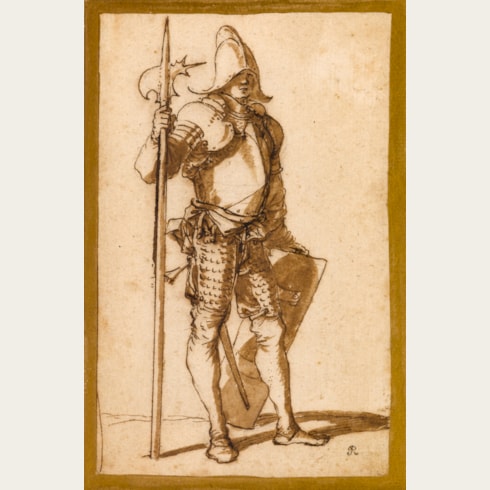Salvator ROSA
(Arenella 1615 - Rome 1673)
A Group of Seven Figures, including a Child Beggar
121 x 196 mm. (4 3/4 x 7 3/4 in.)
The earliest known owner of this drawing was the Provençal nobleman Jean-Baptiste-Florentin-Gabriel de Meyran, Marquis de Lagoy (1764-1829), who assembled a fine collection of drawings that numbered some three thousand sheets by nearly nine hundred artists. Roughly a third of the collection was made up of Italian drawings, including several works by Raphael and Michelangelo, now in the Ashmolean Museum in Oxford.
The present sheet also bears the collector’s mark of the Viennese banker Count Moritz von Fries (1777-1826), who is known to have purchased drawings from the Marquis de Lagoy in 1810. Von Fries assembled a substantial collection of around 100,000 prints and drawings, but financial difficulties forced him to sell much of this collection from 1820 onwards. While his extensive collection of prints was sold in a series of five auctions in Amsterdam and Vienna in 1824 and 1828, the drawings were given to one of his creditors, a certain W. Mellish of London, and were soon dispersed. Some 150 of the drawings were acquired by Sir Thomas Lawrence, and others eventually entered the collection of the Albertina in Vienna.
The present sheet was later part of the large and varied collection of Italian, French, Netherlandish and Spanish drawings, numbering around 1,200 sheets, assembled by the dental surgeon C. R. Rudolf (c.1884-1974) in London from the early 1930s until his death in 1975.
Rosa was a remarkable draughtsman, and his spirited, exuberant drawings were highly praised by connoisseurs even in his own day. The bulk of the nine hundred or so surviving drawings by the artist are figure studies, usually in his preferred medium of pen and ink, and often enlivened with touches of wash. Many of the drawings from the early part of his career are signed, and these may have been sold to collectors or presented as gifts to friends or patrons. However, almost no signed drawings dating from after 1649 exist, and it has been suggested that, after his return to Rome, Rosa chose to keep most of his drawings for himself, and not part with them.
Provenance
Acquired from him in 1810 by Count Moritz von Fries, Vienna (Lugt 2903), his drystamp at the lower left
Presumably W. Mellish, London
Dr. Carl Robert Rudolf, London (Lugt 2811b), his collector’s mark on the verso
Private collection, New York.











